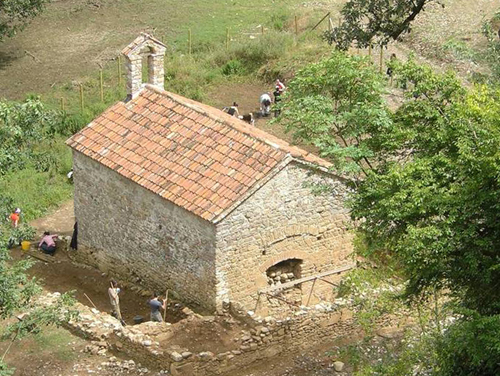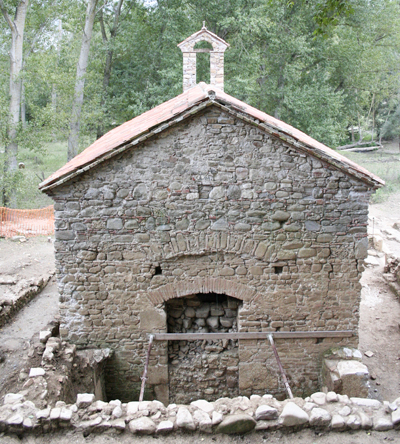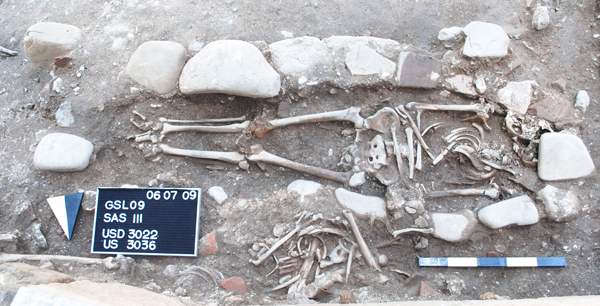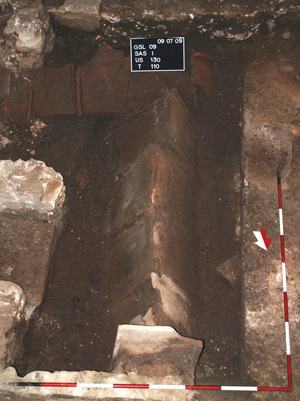The sacred context of St. Laverioby Gioia Bertelli
The building, in a position slightly elevated, is placed in the middle of a flat area affected by the confluence of two rivers: Agri river and Sciaura stream. According to the Passio (that is the narration of martyrdom), written in 1162 by Roberto da Romana, deacon of Saponara, Laverio, at the beginning of fourth century, before emperor Constantine converting himself to Christianity, was beheaded outside the city of Grumentum, at the crossing point between the two rivers, and then buried there. On his burial place it was built by the willingness of Grumentum people a church of great beauty, as the Latin source says.
The church of nineteenth century was affected by restorations that led also to the identification inside the area of a series of structures in relation to the oldest attendance phases in the area, some of which of clearly pagan funerary origin, to be connected with the near Roman city. Inside the church and in the surrounding area archaeological surveys, began in 2008 and now still in progress, permitted to recover various and numerous data that helped to set the area history in a better way, which can be in broad terms outlined in this way.
Related to the early Christian building seem to be the structures reportable to north and south perimeter walls, widely damaged and rebuilt during the time. The northern zone hasn’t been investigated yet, except for the western area, where has been brought to light a quadrangular room and other structures, referring to two ossuaries of later Medieval age, of which just one has been already explored.
Researches relative to excavation campaign in 2010, prevalently concentrated in the eastern area, outside the church, brought to light also here a very thick presence of burials, piled up one upon the other, with orientation east-west, concerning different time of settlements, of which the later should be pertinent to a medieval phase.
Among the resulting material, were recovered numerous fragments of painted plaster, probably to be related with the internal decoration of early Christian church and fragments of plastering. In the western zone, in front of today’s church entrance have been identified two stone sarcophagi, of which one decorated with bucranium, kantharoi, garlands and foliages can be dated to the third century A.C., and some funerary stones reused in the masonry; inside the church, above the altar, was placed a statue of late medieval age depicting St. Laverio; all the artifacts, like other erratics found in the area, are kept at the nearby National Archaeological Museum of Upper Agri Valley.
Copyright text and pictures (where there aren't other references) by Gioia Bertelli. |




 Along the road connecting Grumento Nova with the settlement of Roman city Grumentum, there is a path leading to the area known as St. Laverio. This is nowadays qualified by the presence of a small church with a single nave, trusses roof which, despite of dating back after the earthquake of 1857 and resulting very damaged, still preserves in its building traces of wall related to an oldest construction, while other structures of different epochs are still visible in the surrounding area.
Along the road connecting Grumento Nova with the settlement of Roman city Grumentum, there is a path leading to the area known as St. Laverio. This is nowadays qualified by the presence of a small church with a single nave, trusses roof which, despite of dating back after the earthquake of 1857 and resulting very damaged, still preserves in its building traces of wall related to an oldest construction, while other structures of different epochs are still visible in the surrounding area. According to the testimony provided by the Bios (i.e. life) written by St. Luke of Demenna (died in 995), this man, having found the church abandoned and destroyed, because of Saracen raids during the ninth century, rebuilt it in smaller size, maintaining the same orientation as the previous one, as it seems to indicate, on the western side, the presence of an accessing passage with its threshold, then closed during the reconstruction in nineteenth century.
According to the testimony provided by the Bios (i.e. life) written by St. Luke of Demenna (died in 995), this man, having found the church abandoned and destroyed, because of Saracen raids during the ninth century, rebuilt it in smaller size, maintaining the same orientation as the previous one, as it seems to indicate, on the western side, the presence of an accessing passage with its threshold, then closed during the reconstruction in nineteenth century. In the area of pagan necropolis was, probably in the early fourth century, martyred and buried Laverio; later, maybe between fifth and sixth century, it was built there a church quite large that, from the emerged structures, should have three aisles with apse facing east, now disappeared due to soil sinking, internally divided by arches on pillars, of which still remain some traces included in the current church towards west; along the southern external side towards east, should develop some areas that, as the rest of investigated area, were occupied by a very thick burial series. These ones, often disrupted and desecrated, without funeral kits, result to be of different kinds (Capuchin, slab tombs, bisoma, built in masonry) and reportable to different historical moments; were also found inside the current church and dated, the oldest ones, around fifth-seventh century, and the earliest, to medieval age; it’s particularly interesting among the last ones the burial that gave us a shell of pectens type, typical attribute of who made a pilgrimage to Santiago de Compostela.
In the area of pagan necropolis was, probably in the early fourth century, martyred and buried Laverio; later, maybe between fifth and sixth century, it was built there a church quite large that, from the emerged structures, should have three aisles with apse facing east, now disappeared due to soil sinking, internally divided by arches on pillars, of which still remain some traces included in the current church towards west; along the southern external side towards east, should develop some areas that, as the rest of investigated area, were occupied by a very thick burial series. These ones, often disrupted and desecrated, without funeral kits, result to be of different kinds (Capuchin, slab tombs, bisoma, built in masonry) and reportable to different historical moments; were also found inside the current church and dated, the oldest ones, around fifth-seventh century, and the earliest, to medieval age; it’s particularly interesting among the last ones the burial that gave us a shell of pectens type, typical attribute of who made a pilgrimage to Santiago de Compostela.

